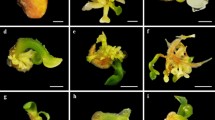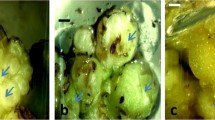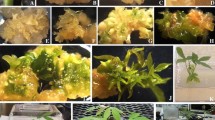Abstract
In the present study, an improved plant regeneration protocol via primary and secondary somatic embryogenesis was established in two Co-1 and Rajendra Swathi (RS) varieties of Coriandrum sativum L. Callus was induced from root explants on 2, 4-D (0.5–2.0 mg/l) supplemented MS. The addition of BA (0.2 mg/l) improved callus induction and proliferation response significantly. The maximum callus induction frequency was on 1.0 mg/l 2, 4-D and 0.2 mg/l BA added MS medium (77.5 % in Co-1 and 72.3 % in RS). The callus transformed into embryogenic callus on 2, 4-D added MS with maximum embryogenic frequency was on 1.0 mg/l. The granular embryogenic callus differentiated into globular embryos on induction medium, which later progressed to heart-, torpedo- and cotyledonary embryos on medium amended with 0.5 mg/l NAA and 0.2 mg/l BA. On an average, 2–3 secondary somatic embryos (SEs) were developed on mature primary SEs, which increased the total embryo numbers in culture. Histology and scanning electron microscopy (SEM) studies are presented for the origin, development of primary and secondary embryos in coriander. Later, these induced embryos converted into plantlets on 1.0 mg/l BA and 0.2 mg/l NAA-amended medium. The regenerated plantlets were cultured on 0.5 mg/l IBA added ½ MS for promotion of roots. The well-rooted plantlets were acclimatized and transferred to soil. The genetic stability of embryo-regenerated plant was analyzed by flow cytometry with optimized Pongamia pinnata as standard. The 2C DNA content of RS coriander variety was estimated to 5.1 pg; the primary and secondary somatic embryo-derived plants had 5.26 and 5.44 pg 2C DNA content, respectively. The regenerated plants were genetically stable, genome size similar to seed-germinated coriander plants.





Similar content being viewed by others
Abbreviations
- 24-D:
-
2,4-dichlorophenoxy acetic acid
- BA:
-
6-Benzyladenine
- GA3 :
-
Gibberellic acid
- IBA:
-
Indole-3-butyric acid
- MS:
-
Murashige and Skoog (1962) medium
- NAA:
-
α-Napthalene acetic acid
- SE:
-
Somatic embryo
- PSE:
-
Primary somatic embryogenesis
- SSE:
-
Secondary somatic embryogenesis
- SEM:
-
Scanning electron microscopy
References
Aslam J, Mujib A, Sharma MP (2014) Somatic embryos in Catharanthus roseus: a scanning electron microscopic study. Not Sci Biol 6(2):167–172
Bhuiyan MNI, Begum J, Sultana M (2009) Chemical composition of leaf and seed essential oil of Coriandrum sativum L. from Bangladesh. Bangladesh J Pharmacol 4:150–153
Carvalho LC, Goulao L, Oliveira C, Goncalves JC, Amancio S (2004) RAPD assessment for identification of clonal identity and genetic stability of in vitro propagated Chestnut hybrids. Plant Cell Tissue Organ Cult 77:23–27
Chandrasekhar T, Hussain TM, Gopal RG, Rao SJV (2006) Somatic embryogenesis of Tylophora indica (Burm.F.) Merril. An important medicinal plant. Int J Appl Sci Eng 4:33–40
Chen RR, Zhang JT, Ping LB, Guo SS, Hao JP, Zhou XM (1995) Somatic embryogenesis and artificial seed in coriander (Coriandrum sativum L.). Biotechnol Agric For 31:334–342
Chithra V, Leelamma S (2000) Coriandrum sativum—effect on lipid metabolism in 1, 2- dimethyl hydrazine induced colon cancer. J Ethnopharmacol 71:457–463
Choudhury RR, Basak S, Ramesh AM, Rangan L (2014) Nuclear DNA content of Pongamia pinnata L. and genome size stability of in vitro-regenerated plantlets. Protoplasma 251:703–709
Clarindo WR, Carvalho CR, Arauojo FS, Abreu IS, Otoni WC (2008) Recovering polyploid papaya in vitro regenerants as screened by flow cytometry. Plant Cell Tissue Organ Cult 92:207–214
Cortes EJ, Gómez AS, Villalobos PR (2004) Anti-mutagenicity of coriander (Coriandrum sativum L) juice on the mutagenesis produced by plant metabolites of aromatic amines. Toxicol Lett 153:283–292
Couillerot JP, Windels D, Vazquez F, Michalski JC, Hilbert JL, Blervacq AS (2012) Pretreatments, conditioned medium and co-culture increase the incidence of somatic embryogenesis of different. Cichorium species Plant Signal Behav 7(1):1–11
Darughe F, Barzegar M, Sahari MA (2012) Antioxidant and antifungal activity of Coriander (Coriandrum sativum L.) essential oil in cake. Int Food Res J 19(3):1253–1260
Das A, Kesari V, Rangan L (2013) Micropropagation and cytogenetic assessment of Zingiber species of Northeast India. 3. Biotech 3:471–479
Delporte F, Muhovski Y, Pretova A, Watillon B (2013) Analysis of expression profiles of selected genes associated with the regenerative property and the receptivity to gene transfer during somatic embryogenesis in Triticum aestivum L. Mol Biol Rep 40:5883–5906
Delporte F, Pretova A, Jardin P, Watillon B (2014) Morpho-histology and genotype dependence of in vitro morphogenesis in mature embryo cultures of wheat. Protoplasma 251:1455–1470
Dolezel J, Greilhuber J, Suda J (2007) Estimation of nuclear DNA content in plants using flow cytometry. Nat Protoc 2:2233–2244
Emamghoreishi M, Khasaki M, Aazam MF (2005) Coriandrum sativum L.: evaluation of its anxiolytic effects in the elevated plus maze. J Ethnopharmacol 96:365–370
Endemann M, Hristoforoglu K, Stauber T, Wilhelm E (2001) Assessment of age-related polyploidy in Quercus robur L. somatic embryos and regenerated plants using DNA flow cytometry. Biol Plant 44:339–345
Giorgetti L, Ruffini Castiglione M, Turrini A, Martini G, NutiRonchi V, Geri C (2011) Cytogenetic and histological approach for early detection of “mantled” somaclonal variants of oil palm regenerated by somatic embryogenesis: first results on the characterization of regeneration system. Caryologia 64:223–234
Głowacka K, Jezowski S, Kaczmarek Z (2010) The effects of genotype, inflorescence developmental stage and induction medium on callus induction and plant regeneration in two Miscanthus species. Plant Cell Tissue Organ Cult 102:79–86
Hamideh J, Khosro P, Javad NDM (2012) Callus induction and plant regeneration from leaf explants of Falcuria vulgaris an important medicinal plant. J Med Plants Res 6(18):3407–3414
Inpuay K, Te-chato S (2012) Primary and secondary somatic embryos as tool for the propagation and artificial seed production of oil palm. J Agric Technol 8(2):597–609
Jana S, Sivanesan I, Lim MY, Jeong BR (2013) In vitro zygotic embryo germination and somatic embryogenesis through cotyledonary explants of Paeonia lactiflora Pall. Flower Res J 21(1):17–22
Jayanthi M, Mandal PK (2001) Plant regeneration through somatic embryogenesis and RAPD analysis of regenerated plants in Tylophora indica (Burm. f. Merrill.). In Vitro Cell Dev Biol-Plant 37:576–580
Jimenez VM (2005) Involvement of plant hormones and plant growth regulators on in vitro somatic embryogenesis. Plant Growth Regul 47:91–110
Johansen DA (1940) Botanical Microtechnique. McCraw-Hill Book, New York, p 523
Junaid A, Mujib A, Bhat MA, Sharma MP (2006) Somatic embryo proliferation, maturation and germination in Catharanthus roseus. Plant Cell Tissue Organ Cult 84:325–332
Kaeppler SM, Kaeppler HF, Rhee Y (2000) Epigenetic aspects of somaclonal variation inplants. Plant Mol Biol 43:179–188
Kim JA, Kim YS, Choi YE (2011) Triterpenoid production and phenotypic changes in hairy roots of Codonopsis lanceolata and the plants regenerated from them. Plant Biotechnol Rep 5:255–263
Kim YJ, Lee OR, Kim KT, Yang DC (2012) High frequency of plant regeneration through cyclic secondary somatic embryogenesis in Panax ginseng. J Ginseng Res 36(4):442–448
Kumar SP, Kumari BDR (2010) Effect of primary and secondary somatic embryogenesis in Safflower (Carthamus tinctorius L) at morphological and biochemical levels. Am-Eurasian J Agric Environ Sci 8(6):784–792
Kumar V, Moyo M, Van Staden J (2015) Somatic embryogenesis of Pelargonium sidoides DC. Plant Cell Tissue Organ Cult 121:571–577
Li Z, Mize K, Campbell F (2010) Regeneration of daylily (Hemerocallis) from young leaf segments. Plant Cell Tissue Organ Cult 102:199–204
Lincy AK, Remashree AB, Sasikumar B (2009) Indirect and direct somatic embryogenesis from aerial stem explants of ginger (Zingiber officinale Rosc.). Acta Bot Croat 68(1):93–103
Liu W, Liang Z, Shan C, Marsolais F, Tian L (2013) Genetic transformation and full recovery of alfalfa plants via secondary somatic embryogenesis. In Vitro Cell Dev Biol-Plant 49:17–23
Lopez PA, Widrlechner MP, Simon PW, Rai S, Boylston TD, Isbell TA, Bailey TB, Gardner CA, Wilson LA (2008) Assessing phenotypic, biochemical and molecular diversity in coriander (Coriandrum sativum L.) germplasm. Genet Resour Crop Evol 55:247–275
Loureiro J, Capelo A, Brito G, Rodriguez E, Silva S, Pinto G, Santos C (2007a) Micropropagation of Juniperus phoenicea from adult plant explants and analysis of ploidy stability using flow cytometry. Biol Plant 51(1):7–14
Loureiro J, Rodriguez E, Doležel J, Santos C (2007b) Two new nuclear isolation buffers for plant DNA flow cytometry: a test with 37 species. Ann Bot 100:875–888
Makowczynska J, Andrzejewska-Golec E, Sliwinska E (2008) Nuclear DNA content in different plant material of Plantago asiatica L. cultured in vitro. Plant Cell Tissue Organ Cult 94:65–71
Martin KP (2004) Plant regeneration through somatic embryogenesis in medicinally important Centella asiatica L. In Vitro Cell Dev Biol-Plant 40:586–591
Matasyoh JC, Maiyo ZC, Ngure RM, Chepkorir R (2009) Chemical composition and antimicrobial activity of the essential oil of Coriandrum sativum L. Food Chem 113:526–529
Murashige T, Skoog F (1962) A revised medium for rapid growth and bioassays with tobacco tissue culture. Physiol Plant 15:473–497
Murthy HN, Hahn EJ, Paek KY (2008) Recurrent somatic embryogenesis and plant regeneration in Coriandrum sativum L. Sci Hortic 118:168–171
Naquvi KJ, Ali M, Ahamad J (2012) Antidiabetic activity of aqueous extract of Coriandrum sativum L. fruits in streptozotocin induced rats. Int J Pharmcol Pharmacol Sci 4(1):239–240
Neha Mohan PV, Suganthi V, Gowri S (2013) Evaluation of anti-inflammatory activity in ethanolic extract of Coriandrum sativum L. using carrageenan induced paw oedema in albino rats. Der Pharm Chem 5(2):139–143
Pal SP, Alam I, Anisuzzaman M, Sarker KK, Sharmin SA, Alam MF (2007) Indirect organogenesis in summer squash (Cucurbita pepo L.). Turk J Agric For 31:63–70
Park SY, Cho HM, Moon HK, Kim YW, Paek KY (2011) Genotypic variation and aging effects on the embryogenic capability of Kalopanax septemlobus. Plant Cell Tissue Organ Cult 105:265–270
Pasternak TP, Prinsen E, Ayaydin F, Miskolczi P, Potters G, Asard H, Van Onckelen HA, Dudits D, Feher A (2002) The role of auxin, pH and stress in the activation of embryogenic cell division in leaf protoplast- derived cells of alfalfa. Plant Physiol 129:1807–1819
Pavlovic S, Vinterhalter B, Zdravkovic-Korac S, Vinterhalter D, Zdravkovic J, Cvikic D, Mitic N (2012) Recurrent somatic embryogenesis and plant regeneration from immature zygotic embryos of cabbage (Brassica oleracea var. capitata) and cauliflower (Brassica oleracea var. botrytis). Plant Cell Tissue Organ Cult 113:497–506
Peyvandi M, Noormohammadi Z, Banihashemi O, Farahani F, Majd A, Hosseini-Mazinani M, Sheidai M (2009) Molecular analysis of genetic stability in long-term micropropagated shoots of Olea euroaea L. (ev. Dezful). Asian J Plant Sci 8:146–152
Piatczak E, Kuzma L, Sitarek P, Wysokinska H (2015) Shoot organogenesis, molecular analysis and secondary metabolite production of micropropagated Rehmannia glutinosa Libosch. Plant Cell Tissue Organ Cult 120:539–549
Pinto G, Loureiro J, Lopes T, Santos C (2004) Analysis of the genetic stability of Eucalyptus globules Labill. Somatic embryos by flow cytometry. Theor Appl Genet 109:580–587
Potter TL, Fagerson IS (1990) Composition of coriander leaf volatiles. J Agric Food Chem 38:2054–2056
Prakash V (1990) Leafy Spices. CRC Press Inc, Boca Raton, pp 31–32
Rewers M, Drouin J, Kisiala A, Sliwinska E, Cholewa E (2012) In vitro regenerated wetland sedge Eriophorum vaginatum L. is genetically stable. Acta Physiol Plant 34:2197–2206
Rose RJ, Mantiri FR, Kurdyukov S, Chen SK, Wang XD, Nolan KE, Sheahan MB (2010) Developmental biology of somatic embryogenesis. In: Pua E-C, Davey MR (eds) Plant developmental biology-biotechnological perspectives, vol 2. Springer, Heidelberg, pp 3–26
Sharmin SA, Alam MJ, Sheikh MMI, Sarker KK, Khalekuzzaman M, Haque MA, Alam MF, Alam F (2014) Somatic embryogenesis and plant regeneration in Wedelia calendulacea Less. An endangered medicinal plant. Braz Arch Biol Technol 57(3):394–401
Siahsar B, Rahimi M, Tavassoli A, Raissi AS (2011) Application of biotechnology in production of medicinal plants. Am-Eurasian J Agric Environ Sci 11(3):439–444
Silva F, Ferreira S, Duarte A, Mendonca DI, Domingues FC (2011) Antifungal activity of Coriandrum sativum L. essential oil, its mode of action against Candida species and potential synergism with amphotericin B. Phytomedicine 19:42–47
Sliwinska E, Thiem B (2007) Genome size stability in six medicinal plant species propagated in vitro. Biol Plant 51:556–558
Swamy NR, Ugandhar T, Praveen M, Venkataiah P, Rambabu M, Upender M, Subhash K (2005) Somatic embryogenesis and plantlet regeneration from cotyledon and leaf explants of Solanum surattense. Indian J Biotechnol 4:414–418
Tawfik AA, Noga G (2002) Cumin regeneration from seedling derived embryogenic callus in response to amended kinetin. Plant Cell Tissue Organ Cult 69:35–40
Verdeil JL, Alemanno L, Niemenak N, Tranbarger TJ (2007) Pluripotent versus totipotent plant stem cells: dependence versus autonomy? Trends Plant Sci 12:245–252
Vidal AM, Costa MAPC, Souza AS, Almeida WAB, Souza FVD (2014) In vitro regeneration and morphogenesis of somatic embryos of cassava. Rev Ciênc Agron 45(3):558–565
Vieira-Santos A, Arrigoni-Blank MF, Fitzgerald-Blank A, Cardamone-Diniz LE, Pereira-Fernandes RM (2011) Biochemical profile of callus cultures of Pogostemon cablin (Blanco) Benth. Plant Cell Tissue Organ Cult 107:35–43
Von Arnold S, Sabala I, Bozhkov P, Dyachok JA, Filonova L (2002) Developmental pathways of somatic embryogenesis. Plant Cell Tissue Organ Cult 69:233–249
Wissowzky A (1876) Ueber das Eosin als reagenz auf Hamoglobin und die Bildung von Blutgefassen und Blutkorperchen bei Saugetier und Hühnerembryonen. Arch Mikrosk Anat 13:479–496
You CR, Fan TJ, Gong XQ, Bian FH, Liang LK, Qu FN (2011) A high-frequency cyclic secondary somatic embryogenesis system for Cyclamen persicum Mill. Plant Cell Tissue Organ Cult 107:233–242
Zhang CX, Li Q, Kong L (2007) Induction, development and maturation of somatic embryos in Bunge’s pine (Pinus bungeana Zucc. ex Endl.). Plant Cell Tissue Organ Cult 91:273–280
Acknowledgments
We are thankful to UGC for the financial assistance in the form of Junior Research Fellowship and to NRCSS, Ajmer, Rajasthan, India, for providing the seeds of coriander varieties, BD-JH FACS Academy, Jamia Hamdard, New Delhi, for providing the facility of flow cytometry.
Author information
Authors and Affiliations
Corresponding author
Ethics declarations
Conflict of interest
The authors declare that they have no conflict of interest.
Additional information
Handling Editor: Pavla Binarova
Rights and permissions
About this article
Cite this article
Ali, M., Mujib, A., Tonk, D. et al. Plant regeneration through somatic embryogenesis and genome size analysis of Coriandrum sativum L.. Protoplasma 254, 343–352 (2017). https://doi.org/10.1007/s00709-016-0954-2
Received:
Accepted:
Published:
Issue Date:
DOI: https://doi.org/10.1007/s00709-016-0954-2




